Abstract
OBJECTIVES: The effect of rhythmic auditory stimulation (RAS) on gait velocity, cadence, stride length, and symmetry was studied in 31 patients with idiopathic Parkinson's disease, 21 of them on (ON) and 10 off medication (OFF), and 10 healthy elderly subjects. METHOD: Patients walked under four conditions: (1) their own maximal speed without external rhythm; (2) with the RAS beat frequency matching the baseline cadence; (3) with RAS 10% faster than the baseline cadence; (4) without rhythm to check for carry over from RAS. Gait data were recorded via a computerised foot switch system. The RAS was delivered via a 50 ms square wave tone embedded in instrumental music (Renaissance style) in 2/4 metre prerecorded digitally on a sequencer for variable tempo reproduction. Patients on medication were tested in the morning 60-90 minutes after medication. Patients off medication were tested at the same time of day 24 hours after the last dose. Healthy elderly subjects were tested during the same time of day. RESULTS: Faster RAS produced significant improvement (P < 0.05) in mean gait velocity, cadence, and stride length in all groups. Close synchronisation between rhythm and step frequency in the controls and both Parkinson's disease groups suggest evidence for rhythmic entrainment mechanisms even in the presence of basal ganglia dysfunction. CONCLUSIONS: The results are consistent with and extend prior reports of rhythmic auditory facilitation in Parkinson's disease gait when there is mild to moderate impairment, and suggest a technique for gait rehabilitation in Parkinson's disease.
Full text
PDF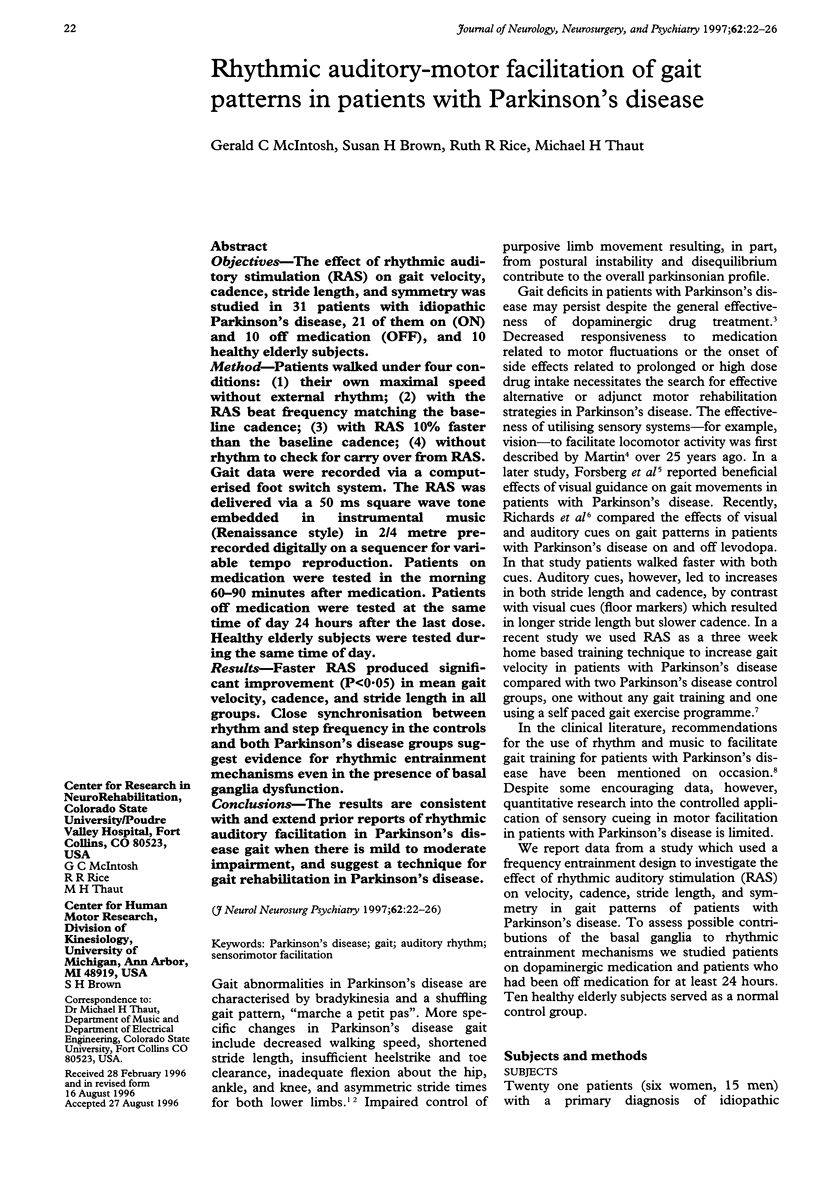
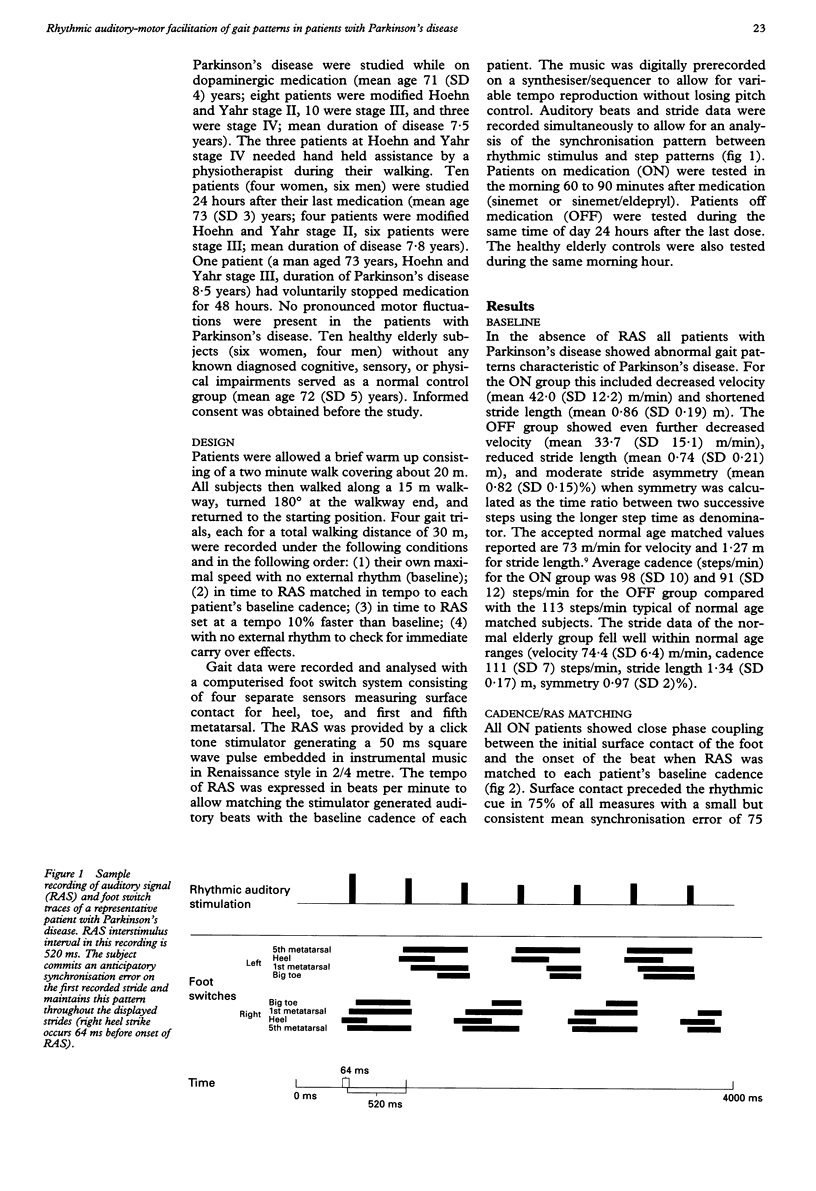
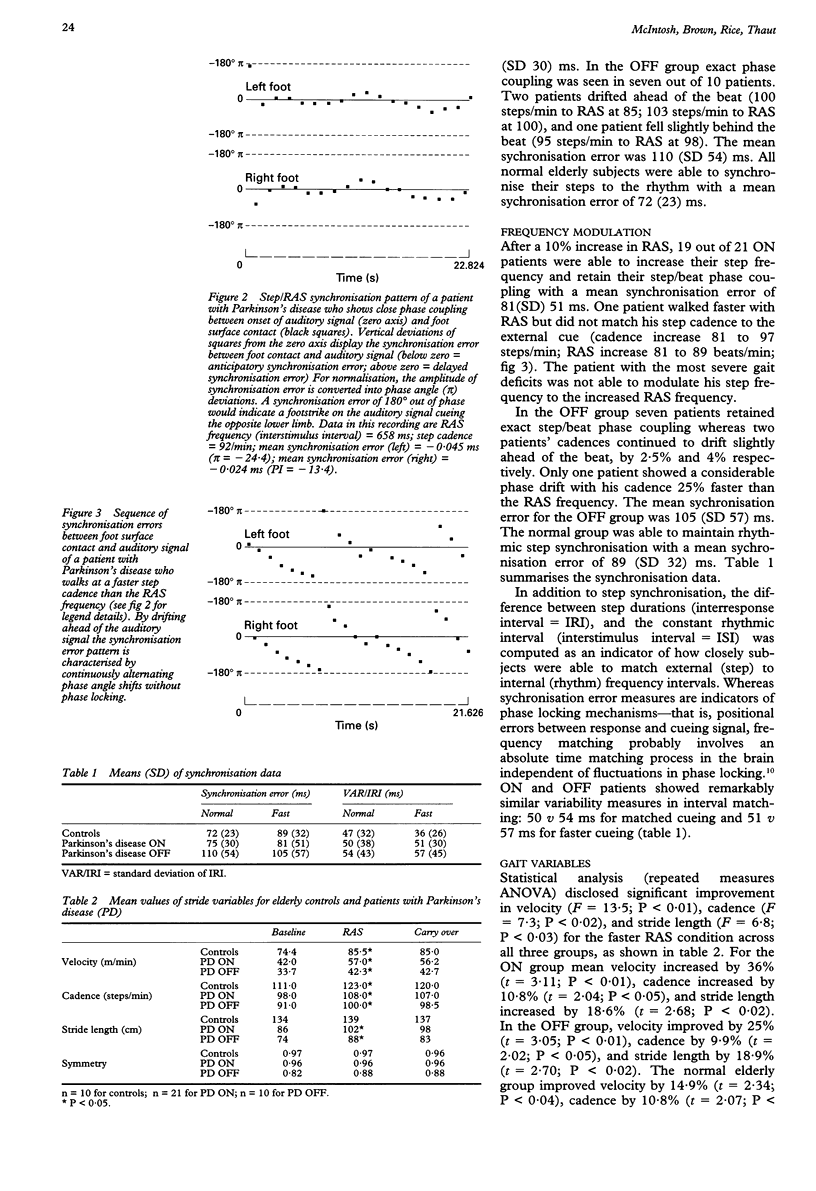
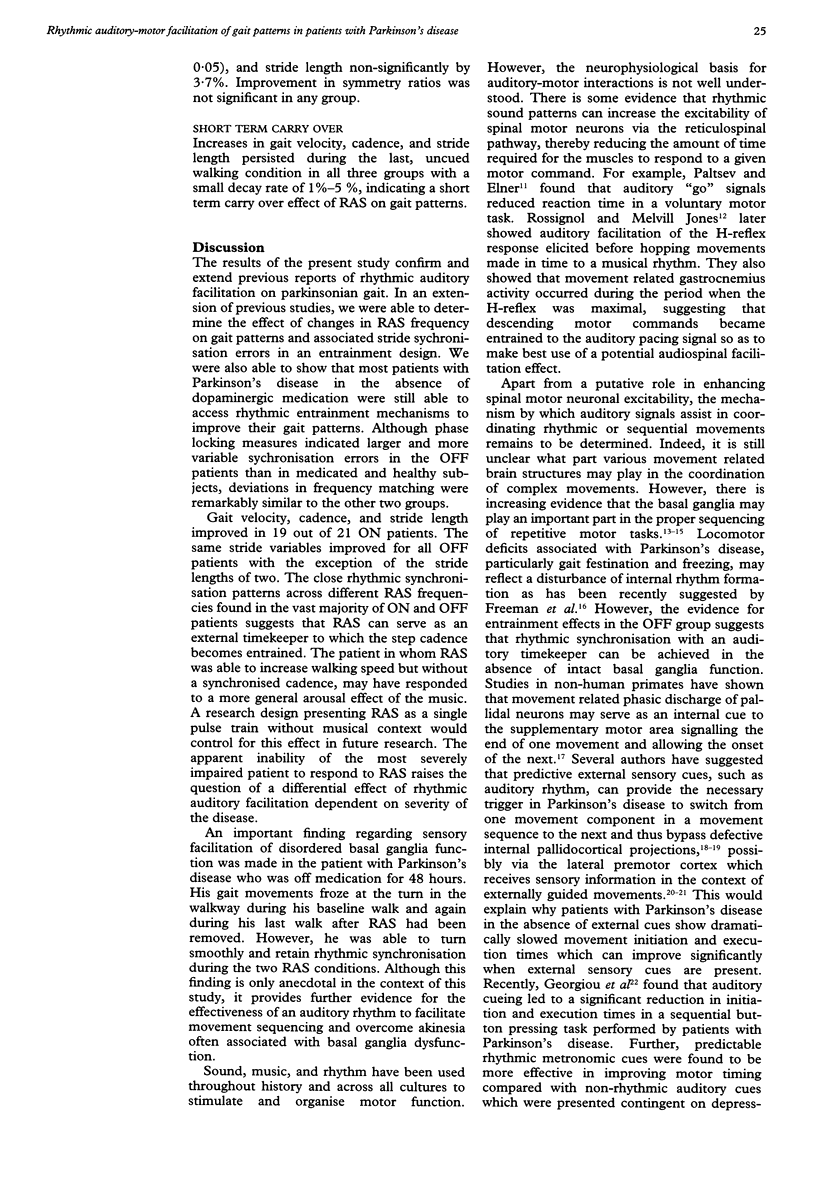
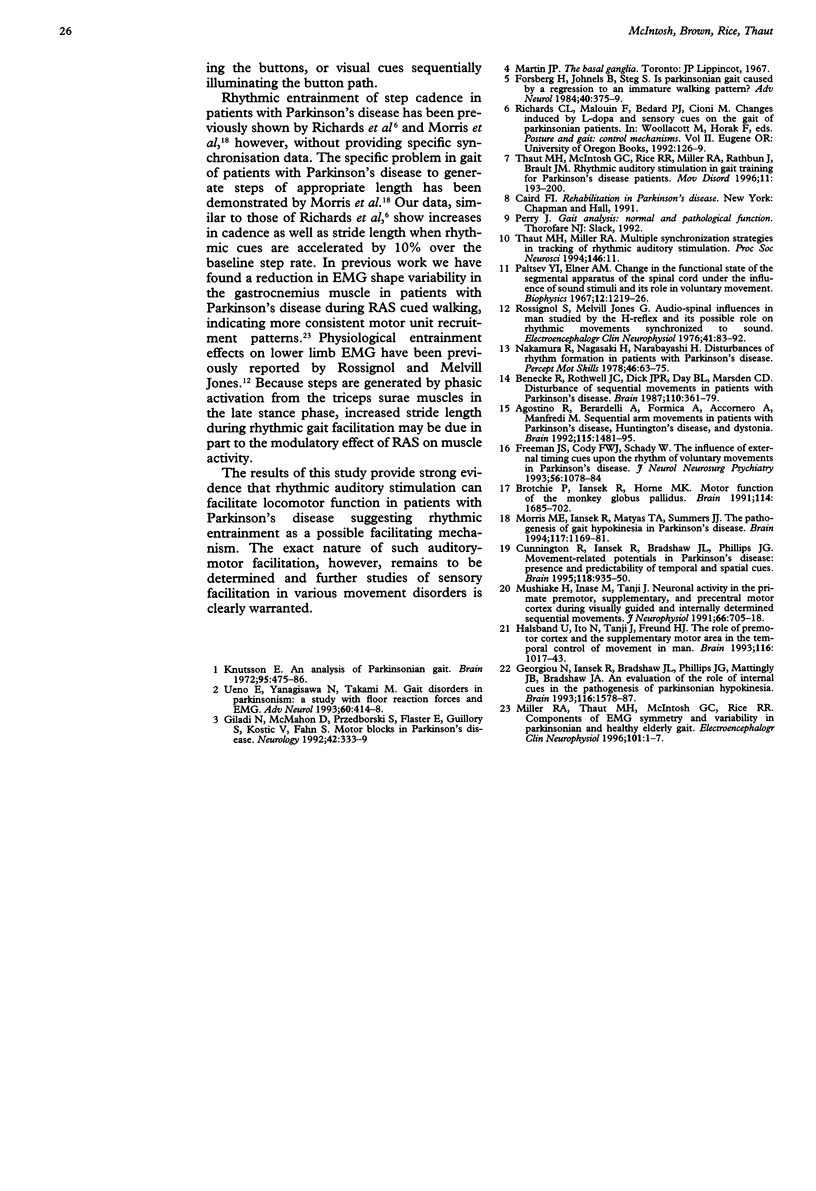
Selected References
These references are in PubMed. This may not be the complete list of references from this article.
- Agostino R., Berardelli A., Formica A., Accornero N., Manfredi M. Sequential arm movements in patients with Parkinson's disease, Huntington's disease and dystonia. Brain. 1992 Oct;115(Pt 5):1481–1495. doi: 10.1093/brain/115.5.1481. [DOI] [PubMed] [Google Scholar]
- Benecke R., Rothwell J. C., Dick J. P., Day B. L., Marsden C. D. Disturbance of sequential movements in patients with Parkinson's disease. Brain. 1987 Apr;110(Pt 2):361–379. doi: 10.1093/brain/110.2.361. [DOI] [PubMed] [Google Scholar]
- Brotchie P., Iansek R., Horne M. K. Motor function of the monkey globus pallidus. 2. Cognitive aspects of movement and phasic neuronal activity. Brain. 1991 Aug;114(Pt 4):1685–1702. doi: 10.1093/brain/114.4.1685. [DOI] [PubMed] [Google Scholar]
- Cunnington R., Iansek R., Bradshaw J. L., Phillips J. G. Movement-related potentials in Parkinson's disease. Presence and predictability of temporal and spatial cues. Brain. 1995 Aug;118(Pt 4):935–950. doi: 10.1093/brain/118.4.935. [DOI] [PubMed] [Google Scholar]
- Forssberg H., Johnels B., Steg G. Is parkinsonian gait caused by a regression to an immature walking pattern? Adv Neurol. 1984;40:375–379. [PubMed] [Google Scholar]
- Freeman J. S., Cody F. W., Schady W. The influence of external timing cues upon the rhythm of voluntary movements in Parkinson's disease. J Neurol Neurosurg Psychiatry. 1993 Oct;56(10):1078–1084. doi: 10.1136/jnnp.56.10.1078. [DOI] [PMC free article] [PubMed] [Google Scholar]
- Giladi N., McMahon D., Przedborski S., Flaster E., Guillory S., Kostic V., Fahn S. Motor blocks in Parkinson's disease. Neurology. 1992 Feb;42(2):333–339. doi: 10.1212/wnl.42.2.333. [DOI] [PubMed] [Google Scholar]
- Knutsson E. An analysis of Parkinsonian gait. Brain. 1972;95(3):475–486. doi: 10.1093/brain/95.3.475. [DOI] [PubMed] [Google Scholar]
- Krarup-Hansen A., Fugleholm K., Helweg-Larsen S., Hauge E. N., Schmalbruch H., Trojaborg W., Krarup C. Examination of distal involvement in cisplatin-induced neuropathy in man. An electrophysiological and histological study with particular reference to touch receptor function. Brain. 1993 Oct;116(Pt 5):1017–1041. doi: 10.1093/brain/116.5.1017. [DOI] [PubMed] [Google Scholar]
- Miller R. A., Thaut M. H., McIntosh G. C., Rice R. R. Components of EMG symmetry and variability in parkinsonian and healthy elderly gait. Electroencephalogr Clin Neurophysiol. 1996 Feb;101(1):1–7. doi: 10.1016/0013-4694(95)00209-x. [DOI] [PubMed] [Google Scholar]
- Morris M. E., Iansek R., Matyas T. A., Summers J. J. The pathogenesis of gait hypokinesia in Parkinson's disease. Brain. 1994 Oct;117(Pt 5):1169–1181. doi: 10.1093/brain/117.5.1169. [DOI] [PubMed] [Google Scholar]
- Nakamura R., Nagasaki H., Narabayashi H. Disturbances of rhythm formation in patients with Parkinson's disease: part I. Characteristics of tapping response to the periodic signals. Percept Mot Skills. 1978 Feb;46(1):63–75. doi: 10.2466/pms.1978.46.1.63. [DOI] [PubMed] [Google Scholar]
- Rossignol S., Jones G. M. Audio-spinal influence in man studied by the H-reflex and its possible role on rhythmic movements synchronized to sound. Electroencephalogr Clin Neurophysiol. 1976 Jul;41(1):83–92. doi: 10.1016/0013-4694(76)90217-0. [DOI] [PubMed] [Google Scholar]
- Thaut M. H., McIntosh G. C., Rice R. R., Miller R. A., Rathbun J., Brault J. M. Rhythmic auditory stimulation in gait training for Parkinson's disease patients. Mov Disord. 1996 Mar;11(2):193–200. doi: 10.1002/mds.870110213. [DOI] [PubMed] [Google Scholar]
- Ueno E., Yanagisawa N., Takami M. Gait disorders in parkinsonism. A study with floor reaction forces and EMG. Adv Neurol. 1993;60:414–418. [PubMed] [Google Scholar]


